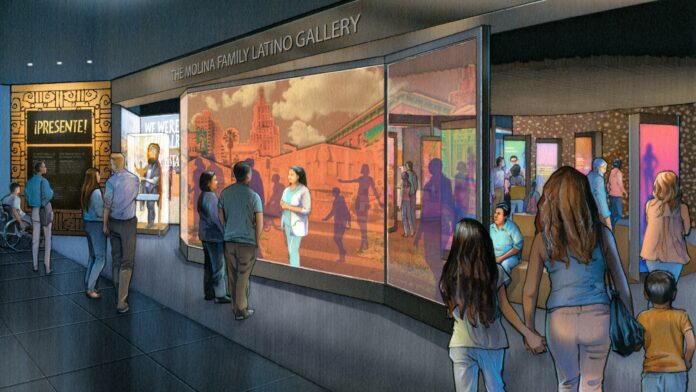The Smithsonian’s National Museum of the American Latino will inaugurate the Molina Family Latino Gallery June 18 with its first exhibition, “¡Presente! A Latino History of the United States.” The Latino Museum will open the gallery at the Smithsonian’s National Museum of American History and offer exhibitions and programs over the course of 10 years leading up to the opening of the museum’s building.
“The Molina Family Latino Gallery is the first iteration of the National Museum of the American Latino,” said Jorge Zamanillo, director of the National Museum of the American Latino. “It will take 10 to 12 years to open a museum building, but the gallery gives the public a preview of the museum’s potential.”
As the Molina Family Latino Gallery’s premiere exhibition, “¡Presente!” introduces visitors to key concepts, moments and biographies that illuminate U.S. Latinos’ historical and cultural legacies. The exhibition also tells the stories of Latinas and Latinos who have shaped the United States. Indigenous freedom fighter Toypurina, Mexican American union leader César Chávez, Puerto Rican baseball player Roberto Clemente, Guatemalan labor organizer Luisa Moreno, Colombian American drag queen José Sarria and Cuban American singer Celia Cruz are some of the historical and contemporary figures featured in the exhibition.
The 4,500-square-foot gallery is designed as a space where multigenerational and cross-cultural visitors can celebrate and learn about Latino history and culture year-round. The Molina Family Latino Gallery is anchored in the universal principles of inclusive design to create a personally engaging and empowering visitor experience for visitors with varying physical, sensory and cognitive conditions. In addition, all content is available in English and Spanish. Audiences can learn how Latinos and Latinas have helped shape the United States and its national culture through historical artifacts, multimedia interactives, sensorial experiences and a learning space.
Ceiling-high object cases organized into four key themes line the gallery’s perimeter and showcase relevant historical artifacts, revealing documents, personal stories and interpretive graphics. The historical themes cover “Colonial Legacies,” “War and U.S. Expansion,” “Immigration Stories,” and “Shaping the Nation.”
Eight-foot-tall interactive digital displays form El Foro (The Forum) at the center of the gallery where visitors can engage with 12 first-person oral histories from contemporary figures. Visitors can select stories through the touchscreen or an adjacent accessibility keypad.
The Somos Theater provides visitors with a contemplative space to watch the multimedia project “Somos” (“We Are”). The video installation was directed by writer and filmmaker Alberto Ferreras. “Somos” is the first commissioned piece for the theater and features a diverse group of Latinas and Latinos discussing identity, family histories and firsthand experiences.
MUSLE, or Mapping the U.S. Latino Experience, delivers visual representations of national demographic data to tell the stories of the Latino experience in the United States. Visitors can activate one of four touchscreens to explore the 16 stories on income inequality, education, diversity and more. Graphs and other images illustrate significant data points and convey stories from community organizations.
The General Motors Learning Lounge, a multifunctional studio within the Molina Gallery, will host presentations and hands-on activities. When needed, the lounge can be converted into a gathering place suitable for storytelling, podcasts and lectures. The General Motors Learning Lounge is part of the Latino Museum’s strategy to enhance lifelong learning and increase access to the collections and resources spanning the arts, sciences and humanities that are available through the Smithsonian, Latino Museum and affiliated museums.
The Molina Family Latino Gallery was made possible by support from individuals, foundations and corporations, including a $10 million lead gift from the family of C. David and Mary Molina. C. David Molina was a healthcare leader in California who founded Molina Healthcare Inc.
“This is a special year for the Molina Family Latino Gallery to open,” said Eduardo Díaz, acting deputy director of the National Museum of the American Latino. “It was 25 years ago that the Smithsonian founded the Latino Center to increase Latino representation across the Institution, which also helped pave the way for the Latino Museum. I am proud to have played a role in the gallery’s development and to help usher in the new Latino Museum.”
To complement the celebration of the gallery’s opening and commemorate 25 years of Latinidad (Latino culture) at the Smithsonian, two days of public events will kick off Hispanic Heritage Month in September, including:
Friday, September 16: Evening Dance Party
An after-hours evening event with music performances, dancing and interactive cultural experiences. The event will feature pop-culture activations and special docent-led tours in the Molina Family Latino Gallery. The event will feature live musical performances and dance workshops. Culturally curated Latino cuisine and specialty beverages will be available for purchase. This is a free and ticketed 21+ event.
Saturday, September 17: Latino Heritage Family Day
An intergenerational festival with enriching educational offerings will feature hands-on activities and performances in celebration of 25 years of Latinidad at the Smithsonian. The event will showcase Latino history, art and culture, highlighting different Smithsonian museums and cultural centers through activities and collections, as well as Latino community partner organizations. Family-fun activities will include a puppet theater and cooking demonstrations as well as pop-culture and adult programming. The day will also spotlight Latinos in sports. It will conclude with a featured evening concert of musical performances that capture the diversity of Latinidad, including urban musical traditions and salsa.






